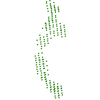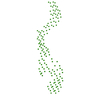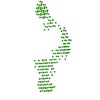+Search query
-Structure paper
| Title | Octa-repeat domain of the mammalian prion protein mRNA forms stable A-helical hairpin structure rather than G-quadruplexes. |
|---|---|
| Journal, issue, pages | Sci Rep, Vol. 9, Issue 1, Page 2465, Year 2019 |
| Publish date | Feb 21, 2019 |
 Authors Authors | Andreas Czech / Petr V Konarev / Ingrid Goebel / Dmitri I Svergun / Peter R Wills / Zoya Ignatova /    |
| PubMed Abstract | Misfolding and aggregation of prion protein (PrP) causes neurodegenerative diseases like Creutzfeldt-Jakob disease (CJD) and scrapie. Besides the consensus that spontaneous conversion of normal ...Misfolding and aggregation of prion protein (PrP) causes neurodegenerative diseases like Creutzfeldt-Jakob disease (CJD) and scrapie. Besides the consensus that spontaneous conversion of normal cellular PrP into misfolded and aggregating PrP is the central event in prion disease, an alternative hypothesis suggests the generation of pathological PrP by rare translational frameshifting events in the octa-repeat domain of the PrP mRNA. Ribosomal frameshifting most commonly relies on a slippery site and an adjacent stable RNA structure to stall translating ribosome. Hence, it is crucial to unravel the secondary structure of the octa-repeat domain of PrP mRNA. Each of the five octa-repeats contains a motif (GGCGGUGGUGGCUGGG) which alone in vitro forms a G-quadruplex. Since the propensity of mRNA to form secondary structure depends on the sequence context, we set to determine the structure of the complete octa-repeat region. We assessed the structure of full-length octa-repeat domain of PrP mRNA using dynamic light scattering (DLS), small angle X-ray scattering (SAXS), circular dichroism (CD) spectroscopy and selective 2'-hydroxyl acylation analysis by primer extension (SHAPE). Our data show that the PrP octa-repeat mRNA forms stable A-helical hairpins with no evidence of G-quadruplex structure even in the presence of G-quadruplex stabilizing agents. |
 External links External links |  Sci Rep / Sci Rep /  PubMed:30792490 / PubMed:30792490 /  PubMed Central PubMed Central |
| Methods | SAS (X-ray synchrotron) |
| Structure data |  SASDDG5:  SASDDH5:  SASDDJ5:  SASDDK5:  SASDDL5:  SASDDM5:  SASDDN5:  SASDDP5: |
| Source |
|
 Movie
Movie Controller
Controller Structure viewers
Structure viewers About Yorodumi Papers
About Yorodumi Papers



